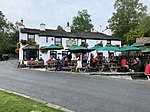Slater's Bridge
Bridges in CumbriaCumbria building and structure stubsUnited Kingdom bridge (structure) stubs

Slater's Bridge is a traditional packhorse bridge in Little Langdale in the English Lake District, standing at National Grid Reference NY3120502996.
Excerpt from the Wikipedia article Slater's Bridge (License: CC BY-SA 3.0, Authors, Images).Slater's Bridge
Slaters' Bridge,
Geographical coordinates (GPS) Address External links Nearby Places Show on map
Geographical coordinates (GPS)
| Latitude | Longitude |
|---|---|
| N 54.41783 ° | E -3.06165 ° |
Address
Slaters' Bridge
Slaters' Bridge
LA22 9PB , Lakes
England, United Kingdom
Open on Google Maps











